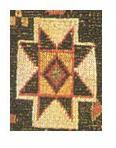| Dear folks -
First, let me acknowledge that I am out of my depth with Wendel's
question.
But I have graduate student tendencies and a reasonable rug library and
sometimes I read things that trigger questions for me.
In her little book "Tribal Rugs," (first published in 1978) Jenny
Housego treats Shahsavan weaving on pages 8-12.
She lists several groups of Shahsavan and seems to acknowledge that
particular features of the weavings among them are different but on page
9, she writes some sentences that attract my attention and that may be
useful in the questions we are considering about the Italian rug and
especially the one in this thread.
Here is what Ms. Housego writes:
"...there appear to be several distinguishing factors of Shahsavan
pieces. One is the wool which in this part of Iran tends to be somewhat
drier and grainy to the touch, as well as being rather darker in color..."
I'm not sure what she means by this sentence. Is she describing modal
tendencies in the wool in Shahsavan pieces [and if so are these qualities
what the expert Daniel quotes above in the original thread of this title
was referring to? (and don't you hate experts who are both conclusionary
and utterly elliptical?)] or is she describing the Persian wool in this
part of the region and saying that Shahsavan wool is different from it?
On page 10 and 11 Ms. Housego discusses the weaving from the Hashtrud
and Khamsa areas and says in this passage:
"...It is the Shahsavan who are responsible for the interesting tribal
weaves. It remains an anomaly, however, that designs, colours, and certain
techniques are quite distinct from those of the Moghan Shahsavan. The wool
is softer, the use of white cotton is rare, colours are more muted, but
above all it is in the repertoire of designs that each clan of the
Shahsavan that the difference is most apparent. It is likely that
traditionally each clan of the Shahsavan had its own designs. These,
perhaps, remained intact among groups that were sent south, while the
influx of Caucasian tribes into the Moghan Shahsavan in the later
nineteenth century significantly influenced the weaving of those who
remained behind..."
This second passage seems to me to suggest that she IS saying that the
wool used by the Moghan Shahsavans is what she was talking about on page
9, when she uses the words "drier," "grainy," and "darker."
Just below the passage I quoted on page 9, Ms. Housego also talks about
forms in Shahsavan pieces that move beyond the geometric.
She says: " Another (ed. distinghishing feature of Shahsavan pieces) is
the predeliction of the Persian weaver for incidental detail - human
figures, animals, birds, floral or tree forms - interspersed randomly
through the main elements. The Caucasian was perhaps more concerned with
fineness of weave, clear line and an uncluttered field."
What are we to make of what she says in these passages? Is she giving
us something potentially useful to the issues in this thread and salon?
Are her 1978 comments still cogent or have they been passed by now by
subsequent analysis?
Regards,
R. John Howe | 


